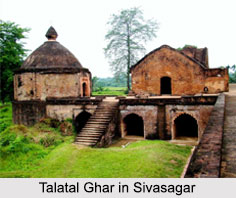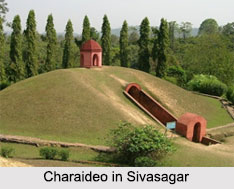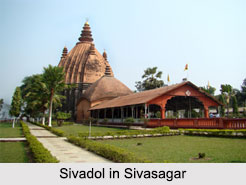 Sivasagar District is located in the Indian state of Assam, which was formerly known as Sibsagar. Sivasagar city is the district headquarters. This historical place, covering an area of 2668 sq. km., is also known for its rich biodiversity. The district, comprised of two sub-divisions Sivasagar and Nazira, lies between 26.45 degrees north and 27.15 degrees north latitudes and 94.25 degrees east and 95.25 degrees east longitudes. Sivasagar District is encompassed by the Brahmaputra River to the north, Nagaland to the south, Charaideo District to the east and Jhanji River to the west. Oil industry and tea industry are a few of the most significant local industries of this district. The major portion of the local population here is associated with agriculture.
Sivasagar District is located in the Indian state of Assam, which was formerly known as Sibsagar. Sivasagar city is the district headquarters. This historical place, covering an area of 2668 sq. km., is also known for its rich biodiversity. The district, comprised of two sub-divisions Sivasagar and Nazira, lies between 26.45 degrees north and 27.15 degrees north latitudes and 94.25 degrees east and 95.25 degrees east longitudes. Sivasagar District is encompassed by the Brahmaputra River to the north, Nagaland to the south, Charaideo District to the east and Jhanji River to the west. Oil industry and tea industry are a few of the most significant local industries of this district. The major portion of the local population here is associated with agriculture.
History of Sivasagar District
Before the British period, Sivasagar was the center of administration for Assam. The famous Ahom Dynasty ruled here for almost 600 years. They built different temples dedicated to different deities, which are the parts of tourism in this district. Rongpur, part of Sivasagar, was the capital of the Ahom kingdom from 1699 to 1788. Sivasagar District was created after the annexation of Purandar Singha"s dominion of upper Assam in 1839.
Geography of Sivasagar District
Fertile alluvial plains are present on the southern and south-eastern regions of this district near the border of Nagaland. Desang River, Janji River, Dikhow and Darika River are the important rivers which flow across this district. Sivasagar district possesses many other rivers as well.
 Climate of Sivasagar District
Climate of Sivasagar District
Pleasant springs, chilly winters and abundant rainfalls are interesting geographical features of Sivasagar District. Frequent rainfall which occurs here ensures that the district escapes humidity. From October onwards, autumn season arrives in this district and the winter season starts from the beginning of the month of November, continuing till February. During the periods of March to May, thunderstorms are witnessed. The months of July, till August experience the maximum temperature.
Demography of Sivasagar
According to the 2011 Indian census, Sivasagar had a population of 1,150,253. It ranks 406th out of 640 in India in terms of population. Sivasagar has a sex ratio of 951 females for every 1000 males and a literacy rate of 81.36%.
Culture of Sivasagar District
Assamese is the mother tongue of the inhabitants of Sivasagar District, while English is another official language of the residents of Sivasagar. Other languages spoken here are Hindi and Bengali. Mising tribes and Deori tribes communicate with the aid of their individual languages. The concept of polygamy is strictly prohibited. Popular festivals celebrated in Sivasagar are Diwali, Kali Puja, Holi, "Nama Kirtana", "Lakshmi Puja", "Sivaratri Mela" etc. Tribal festive occasions involve "Deori Bihu", "Medam-Me-Fi", "Ali-I-Legang" and other festivities. "Bihu" is considered the most important local festival here, which is organised and enjoyed immensely by the people of Sivasagar. They also celebrate a spring festival, which is termed as the "Rangali Bihu", and is carried out in order to celebrate the onset of the agricultural season. Trousers, "dhoti", "churidar", "chadar" and shirts comprise male costumes while the dresses used by the women are blouse, sarees, "Mekhela" and "Riha". Gold and silver jewelries are favoured by the local womenfolk.
 Flora and Fauna in Sivasagar District
Flora and Fauna in Sivasagar District
Panidihing Wildlife Sanctuary was established in Sivasagar district in the year 1999 and it boasts of a total surface area of about 34 square kilometers. Geleky, Dilli, Saleh, Diroi and Abhaypur are some of the reserve forests existent in this region. There are several other beautiful forests, particularly near the borders of Arunachal Pradesh and Nagaland. Trees like "Mekai", "Hollong", "Nahor", "Titachapa" etc are the various tropical evergreen trees which grow in these portions of the nation. Sun bear, tiger, elephant, sambar, hoolock gibbon and other mammals representing the endangered and rare wildlife species of this area.
Tourism in Sivasagar District
Sivasagar District houses several tourist spots some of which are Rang Ghar, Kareng Ghar, Talatal Ghar, Shivadol, Gauridol, Vishnudol, Joydul, Charaideo, Namdang Bridge, Ajan Pir Dargah and others. Some of these are detailed below:
Talatal Ghar: Talatal Ghar is popularly known as a historical site, which was built in the erstwhile capitals of Ahom kingdom.
Charaideo: Charaideo was the first permanent capital of the Ahom kingdom established by the first Ahom king Chao Lung Siu-Ka-Pha in 1253 CE.
Sivadol: It is a group of structures comprising three Hindu temples of Sivadol, Vishnudol and Devidol shrines and a museum.
Visiting Information to Sivasagar District
Sivsagar Railway Station and Dibrugarh Airport are the nearest to reach the district.



















